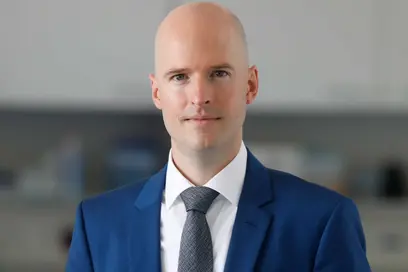Angiogenesis, the growth of new blood vessels, is a complex process that involves numerous signaling proteins. One of these, a growth factor called VEGF, binds to its receptor on the surface of blood vessel cells and sends a signal that they should divide. This causes the formation of a new vascular “sprout" that has a tip marked by a special type of “tip cell." It grows toward the source of VEGF. On its surface, the tip cell produces a molecule called DLL4 that binds to Notch receptors in neighboring vascular cells; this activates the so-called Notch signaling pathway. One result is that VEGF receptors on the neighboring cells disappear. Since the Notch signaling pathway remains inactive in the tip cell, it is the only type that can respond to the growth factor.
VEGF plays a key role not only in wound healing, but also in cancer. After reaching a size of approximately two millimeters, a tumor can no longer feed directly on nutrients and oxygen in its surroundings and therefore needs to be supplied through the formation of new blood vessels. To do so, it releases VEGF. “Drugs that support cancer treatment by blocking the growth factor have been available for some time now," says Associate Professor (PD) Dr. Andreas Fischer, who leads the Helmholtz Junior Research Group “Vascular Signaling and Cancer" at DKFZ. “However, some malignant tumors become resistant to such VEGF inhibitors. Therefore, we are searching for ways to use the Notch signaling pathway to suppress the effects of VEGF."
The scientists focused their attention on a binding protein called SYNJ2BP. “Based on its structure, we thought that it could bind to DLL4 and either weaken or increase its effect," says Dr. Gordian Adam, first author of the article. To pursue this question, the researchers studied the growth behavior of genetically modified vascular cells. Those which were unable to form SYNJ2BP barely activated the Notch signaling pathway; extreme large quantities of tip cells were formed, resulting in a chaotic vascular network. However, if the cells produced larger amounts of this binding protein, the Notch signaling pathway was overactive, leading to reduced levels of VEGF receptors. As a result, hardly any new blood vessels formed.
The scientists were surprised to discover where SYNJ2BP is formed: The binding protein is barely present in the tip cell, where large amounts of DLL4 are found. Instead, it is found in the cells that surround the new blood vessel. The researchers also found low levels of DLL4 in these cells, which explains the role of SYNJ2BP. “SYNJ2BP stabilizes low DLL4 protein levels in cells that immediately follow the tip cell and thus facilitates signal transduction to all other neighboring cells," Adam says. This ensures that all cells – except the tip cell – activate the Notch signaling pathway and no longer respond to the VEGF growth factor.
Now the researchers plan to turn off the SYNJ2BP gene and investigate the impact of the resulting chaotic vascular system on tumor growth. However, the scientists think that SYNJ2BP is unlikely to serve as a potential target for therapies in the near future. “This protein has a very special structure that we have not yet been able to block effectively," says Fischer. “We will investigate how much SYNJ2BP protein is produced in tumor tissue and whether this information can be used to assess the course of the disease."
Adam MG, Berger C, Feldner A, Yang WJ, Wüstehube-Lausch J, Herberich SE, Pinder M, Gesierich S, Hammes HP, Augustin HG, Fischer A. Synaptojanin-2 Binding Protein Stabilizes the Notch Ligands DLL1 and DLL4 and Inhibits Sprouting Angiogenesis. Circ Res. 2013; 113 (11): 1206-1218
A picture for this press release is available at:
ausschnitt-netzhaut.jpg
Caption: Section from a retina: Blood vessels are stained yellow, the binding protein SYNJ2BP is stained pink. The latter is mainly present in the new vascular cells (right) and is scarcely found in the tip cells.
Picture source: Dr. Gordian Adam/DKFZ



